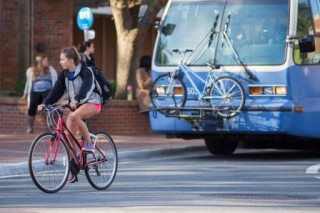Bicyclists Willing to Ride Up to 3 Miles to Catch Bus, Train

Amy L. Stuart UF/IFAS photographer Up to 4 percent of those who take a bus or train to work rode bicycles to get to the transit hub, new UF/IFAS research shows. Those bicyclists pedaled an average of 2 miles to the stations, according to data analyzed by UF/IFAS geomatics Associate Professor Henry Hochmair.
Methods to do so could include installing bicycle lanes separated from vehicular traffic, adding off-street multipurpose paths for pedestrians and bicyclists and converting car lanes to bike-only lanes, said UF geomatics Associate Professor Henry Hochmair.
Hochmair reached his conclusions by studying data collected by transit agencies from passengers who rode trains and buses in three metro areas – Atlanta, Los Angeles and Minneapolis-St. Paul.
From those who completed the survey, Hochmair analyzed trips from 157 people in Los Angeles, 66 in Atlanta and 99 in Minneapolis who rode their bikes to access transit – 2.3 percent, 0.3 percent, and 4.2 percent, respectively. In Hochmair’s data analysis, those who opted to ride a bike to a transit hub cycled an average of 1 to 2 miles in Atlanta and the Twin Cities and 3 miles in Los Angeles.
Hochmair had expected to find more people riding their bicycles to transit hubs based on statistics on commuters from other countries. He cited the Netherlands, where 35 percent of those who ride the bus or train take their bikes to a transit hub.
“That shows what would be possible with appropriate infrastructure and transit policies,” he said.
Bicycling fatalities are up recently. Florida deaths rose by 37 from 2010 to 2012, up to 120, according to a 2012 study by the Governors Highway Safety Association, a nonprofit group that pushes government to improve bicycle safety. These figures underscore Hochmair’s push for better bicycle infrastructure, which may bring the added bonus of more cyclists to transit hubs.
But there are challenges.
Since U.S. cities are built for cars, using five- or six-lane highways, surrounded by shopping centers and subdivisions, there is little room or incentive for alternative transportation, Hochmair said. Additionally, roads in many neighborhoods often contain cul-de-sacs and looping roads, resulting in longer distances for bicyclists to travel. This further discourages bicycling in urban and suburban areas, he said.
Hochmair, who conducts research from UF’s Fort Lauderdale Research and Education Center, said his study’s findings are critical to reducing vehicular traffic.
“The overall goal of transportation planners is to reduce the dependency on individual car traffic and reduce congestion,” said Hochmair, an Institute of Food and Agricultural Sciences faculty member. The average U.S. commute time for a full-time worker is 23 minutes by car, thus too far to walk and possibly too far to cycle, he said. “Using bike and transit combined is a viable alternative to car traffic.”
As part of his research program, Hochmair uses geographic information systems to quantify how road and transit hub designs affect people’s travel behavior and how improving those networks can make transportation more sustainable, for example, by encouraging cycling, walking, and riding buses and trains.
“The over-dependency on cars and lack of physical activity has led to dramatically increased rates of obesity, which makes the facilitation and promotion of physical activity, including walking and cycling, a high public health priority,” he said.
Hochmair’s research is published in the current issue of International Journal of Sustainable Transportation.
UF’s geomatics program, offered at the Fort Lauderdale REC, offers degree programs including professional surveying, geographic information systems, global positioning systems, photogrammetry, cartography and remote sensing.
By Brad Buck, 352-294-3303, bradbuck@ufl.edu
Source: Henry Hochmair, 954-577-6317, hhhochmair@ufl.edu
Media Contact
More Information:
http://www.ufl.eduAll latest news from the category: Transportation and Logistics
This field deals with all spatial and time-related activities involved in bridging the gap between goods and people, including their restructuring. This begins with the supplier and follows each stage of the operational value chain to product delivery and concludes with product disposal and recycling.
innovations-report provides informative reports and articles on such topics as traffic telematics, toll collection, traffic management systems, route planning, high-speed rail (Transrapid), traffic infrastructures, air safety, transport technologies, transport logistics, production logistics and mobility.
Newest articles

NASA: Mystery of life’s handedness deepens
The mystery of why life uses molecules with specific orientations has deepened with a NASA-funded discovery that RNA — a key molecule thought to have potentially held the instructions for…

What are the effects of historic lithium mining on water quality?
Study reveals low levels of common contaminants but high levels of other elements in waters associated with an abandoned lithium mine. Lithium ore and mining waste from a historic lithium…

Quantum-inspired design boosts efficiency of heat-to-electricity conversion
Rice engineers take unconventional route to improving thermophotovoltaic systems. Researchers at Rice University have found a new way to improve a key element of thermophotovoltaic (TPV) systems, which convert heat…



